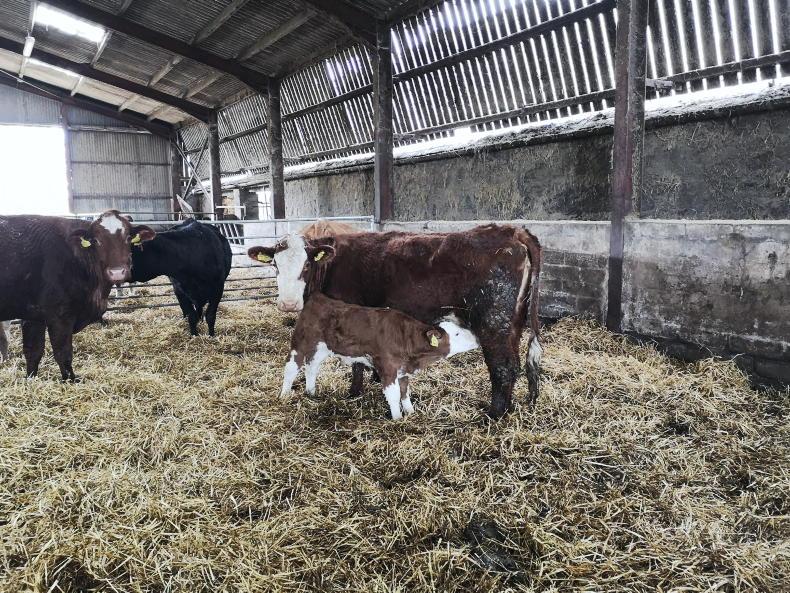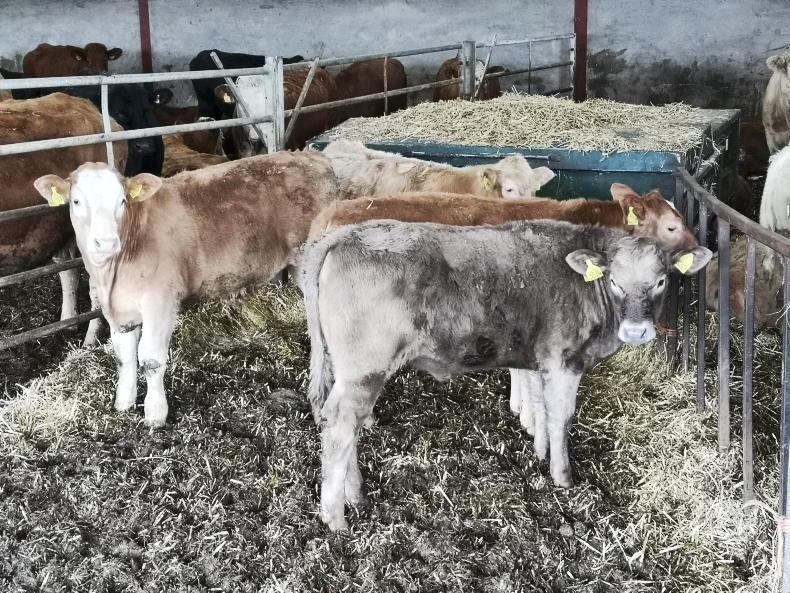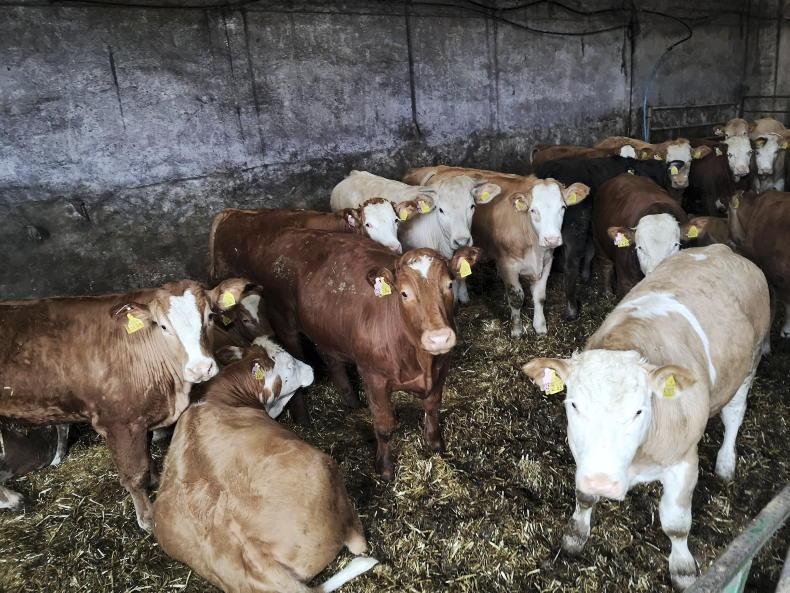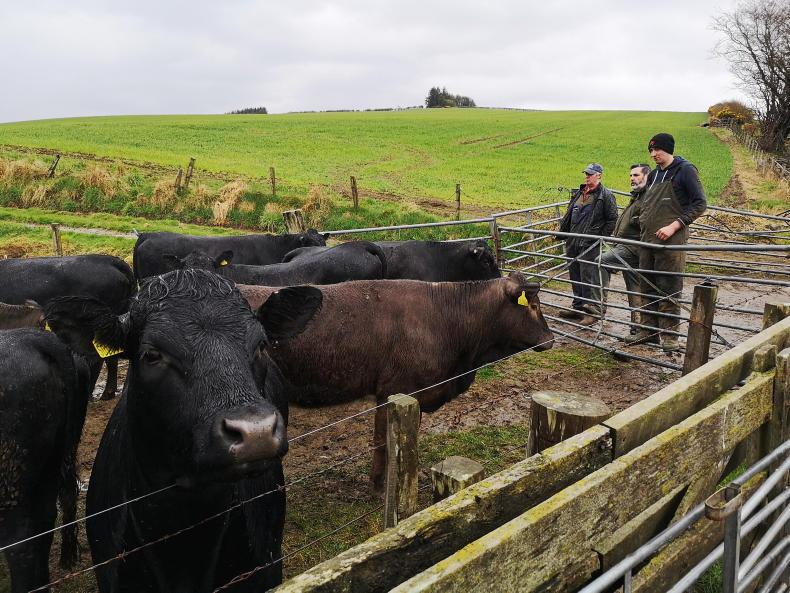Arthur Duguid at Cranna told us this week: “We have had all kinds of weather. Sun, rain and snow. We have had some much colder days and nights than usual, which has held the grass back compared to last year. It has been dry in April but the last few days we have had some welcome showers.”
With 160 cows to calve at Cranna, it is a busy time for the family. So far, 53 have calved and all but three have a thriving calf. One cow had a stillborn calf, one lost a set of twins and a heifer cast her calf.
Arthur was keen to keep one of his cows which lost her calf as she has plenty of milk and a good temperament. He bought a pure Simmental steer from a neighbouring farm for £300 to foster on and it is working well.
“We buy in a few calves each year for cows who lose their calves,” explained Arthur.
“This one looked decent and was advertised on Facebook from a farm 25 miles away so we bought it. The price was the same as what we were paying last year.”
The calvings have been fairly straightforward with only five cows needing assistance at birth.

New calves born this April.
Other than the sickly twins who didn’t make it, no other calves have needed assistance suckling their mothers. Arthur uses Charolais and Limousin bulls which are all producing easy calving calves.
The cows are being fed 20-25kg of feed which is made up of three-quarters silage and one-quarter straw. The cows then get minerals added on top of the silage and have access to additional straw in hakes.
Up until this week, the cows were also getting some soya in their diet but Arthur is taking this out as he suspects this is making the milk too rich and causing the calves to scour. The cows are fed in the evening which results in far fewer births during the night.
Autumn calvers
The autumn-calving cows and calves are performing well, with all of them housed in one shed.
During the day the cows are shut in at the back of the shed with the calves getting access to feed on their own.

The Duguids' autumn-born calves.
Then the cows get let out at 5pm when they are fed the same silage and straw ration as the spring-calvers.
The cows had been getting barley up until three weeks ago when the bulls were still in the pens. The calves also have creep feed in the courts too.
Arthur hopes to get the cows and calves out in two weeks’ time once the grass starts to take off.
Arthur is also looking to get some replacement heifers in for the flock. He will soon be buying around 16 heifers at 12 months of age for bulling.
The heifers will likely be Angus or Saler breeding and will weigh at least 460kg.
Selling stores
Stores are getting ready for sale this week. They have been on a diet of barley, soya, rapemeal and silage as well as hashed turnips.
“I am pleased with how they look,” said Arthur.

Spring 2020-born stores ready for the mart this week.
“They are heavier than this time last year, with some over 500kg and the average would be 460kg to 470kg. They are last year’s April-born calves so most will be around 12 months old when they go through the ring.
“I am not sure exactly why they are heavier than last year, they have maybe had better silage and have gotten more neeps to eat. We also improved the ventilation in the shed which could also have helped.”
Sheep
The bought-in broken-mouthed ewes have now all lambed and been sold with lambs at foot. They started lambing on 10 March and were put to the mart with their lambs once they were a month old.
Sheep costings
“The ewes have been bought half by the farm and half by my son Scott,” explained Arthur.
“It was been a success I would say. However, it does extend the lambing period to six weeks which is a fair haul.”
The Duguids are keen to lamb extra ewes again but might take the date forward a week so there is a gap between the main flock and the early lambers. The ewes cost £94/head which is between half to three-quarters the price of a gimmer which is around what Arthur expects to pay this year.
The main flock of ewes has only a handful left to lamb. Arthur is happy with the amount of lambs and he is pleased how the new Hampshire Down tup performed in the flock. The sheep have been batched up for the 33 acres of paddocks they will be grazing. They will be stocked at eight ewes with lambs to the acre in batches of around 160 to 170 depending on the growing season.
Winter preparations
Despite cattle still in the shed and lambs newly born the Duguids are planning for next winter. The fodder beet will be sown around 5 to 6 May and the turnips the week after.
Arthur Duguid at Cranna told us this week: “We have had all kinds of weather. Sun, rain and snow. We have had some much colder days and nights than usual, which has held the grass back compared to last year. It has been dry in April but the last few days we have had some welcome showers.”
With 160 cows to calve at Cranna, it is a busy time for the family. So far, 53 have calved and all but three have a thriving calf. One cow had a stillborn calf, one lost a set of twins and a heifer cast her calf.
Arthur was keen to keep one of his cows which lost her calf as she has plenty of milk and a good temperament. He bought a pure Simmental steer from a neighbouring farm for £300 to foster on and it is working well.
“We buy in a few calves each year for cows who lose their calves,” explained Arthur.
“This one looked decent and was advertised on Facebook from a farm 25 miles away so we bought it. The price was the same as what we were paying last year.”
The calvings have been fairly straightforward with only five cows needing assistance at birth.

New calves born this April.
Other than the sickly twins who didn’t make it, no other calves have needed assistance suckling their mothers. Arthur uses Charolais and Limousin bulls which are all producing easy calving calves.
The cows are being fed 20-25kg of feed which is made up of three-quarters silage and one-quarter straw. The cows then get minerals added on top of the silage and have access to additional straw in hakes.
Up until this week, the cows were also getting some soya in their diet but Arthur is taking this out as he suspects this is making the milk too rich and causing the calves to scour. The cows are fed in the evening which results in far fewer births during the night.
Autumn calvers
The autumn-calving cows and calves are performing well, with all of them housed in one shed.
During the day the cows are shut in at the back of the shed with the calves getting access to feed on their own.

The Duguids' autumn-born calves.
Then the cows get let out at 5pm when they are fed the same silage and straw ration as the spring-calvers.
The cows had been getting barley up until three weeks ago when the bulls were still in the pens. The calves also have creep feed in the courts too.
Arthur hopes to get the cows and calves out in two weeks’ time once the grass starts to take off.
Arthur is also looking to get some replacement heifers in for the flock. He will soon be buying around 16 heifers at 12 months of age for bulling.
The heifers will likely be Angus or Saler breeding and will weigh at least 460kg.
Selling stores
Stores are getting ready for sale this week. They have been on a diet of barley, soya, rapemeal and silage as well as hashed turnips.
“I am pleased with how they look,” said Arthur.

Spring 2020-born stores ready for the mart this week.
“They are heavier than this time last year, with some over 500kg and the average would be 460kg to 470kg. They are last year’s April-born calves so most will be around 12 months old when they go through the ring.
“I am not sure exactly why they are heavier than last year, they have maybe had better silage and have gotten more neeps to eat. We also improved the ventilation in the shed which could also have helped.”
Sheep
The bought-in broken-mouthed ewes have now all lambed and been sold with lambs at foot. They started lambing on 10 March and were put to the mart with their lambs once they were a month old.
Sheep costings
“The ewes have been bought half by the farm and half by my son Scott,” explained Arthur.
“It was been a success I would say. However, it does extend the lambing period to six weeks which is a fair haul.”
The Duguids are keen to lamb extra ewes again but might take the date forward a week so there is a gap between the main flock and the early lambers. The ewes cost £94/head which is between half to three-quarters the price of a gimmer which is around what Arthur expects to pay this year.
The main flock of ewes has only a handful left to lamb. Arthur is happy with the amount of lambs and he is pleased how the new Hampshire Down tup performed in the flock. The sheep have been batched up for the 33 acres of paddocks they will be grazing. They will be stocked at eight ewes with lambs to the acre in batches of around 160 to 170 depending on the growing season.
Winter preparations
Despite cattle still in the shed and lambs newly born the Duguids are planning for next winter. The fodder beet will be sown around 5 to 6 May and the turnips the week after.









 This is a subscriber-only article
This is a subscriber-only article










SHARING OPTIONS: